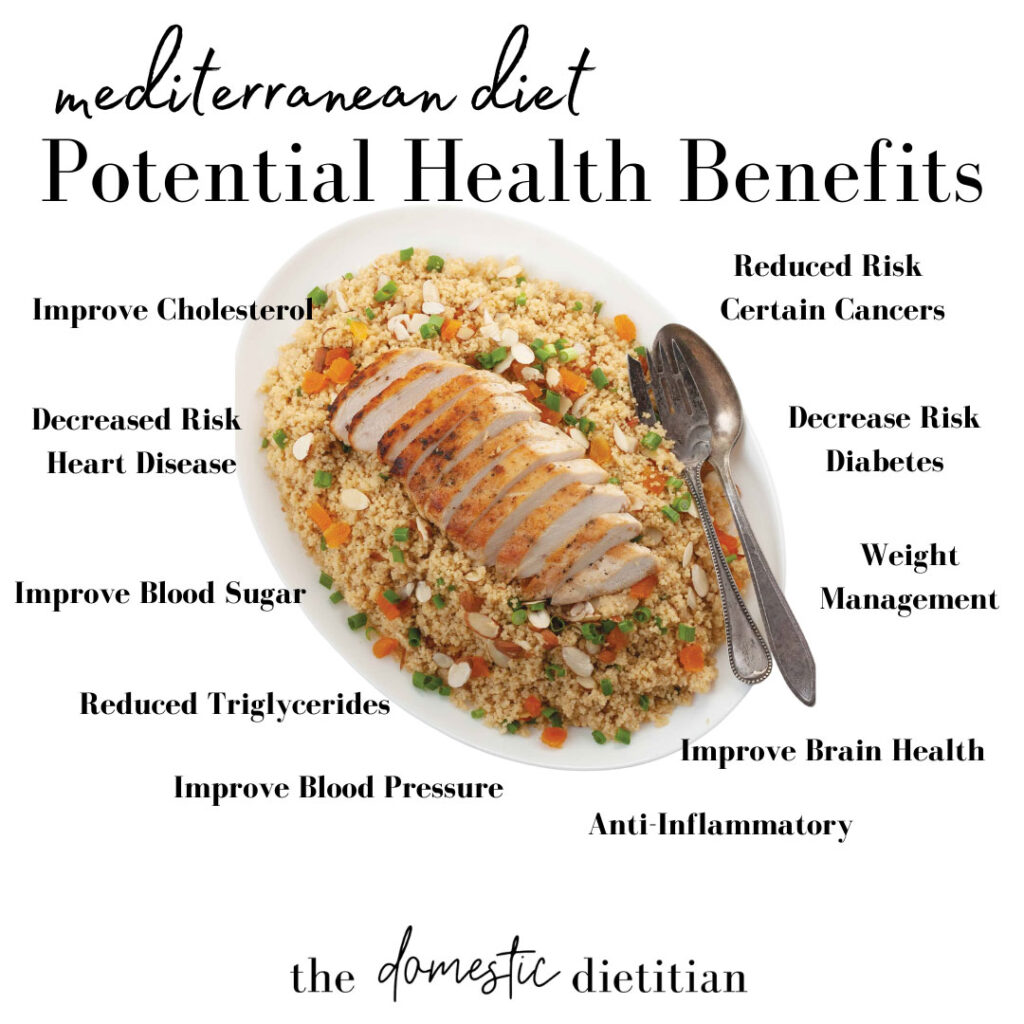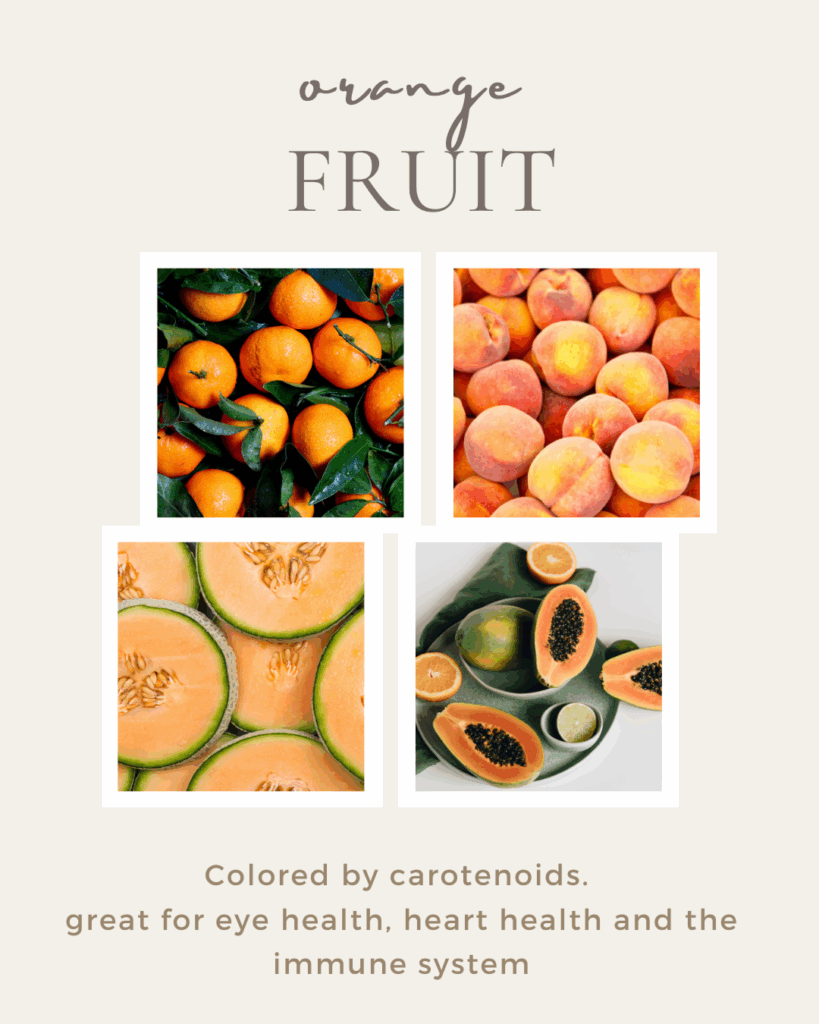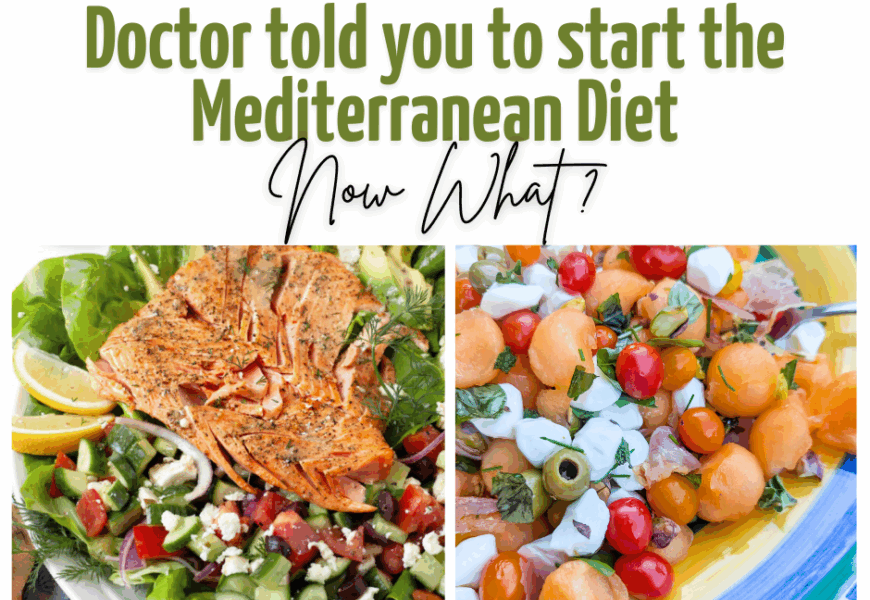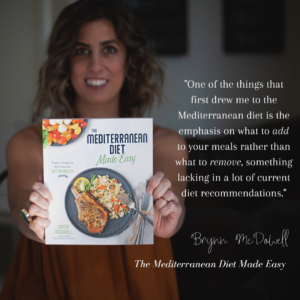We hear it all the time. My doctor told me to start the Mediterranean diet because of (fill in blank) but where do I even begin? Well you’ve come to the right place. Sharing our expertise on starting the Mediterranean diet in your own home.
Why Doctors Recommend the Mediterranean Diet
I do a happy dance every time I hear that a doctor recommends the Mediterranean Diet to a patient. Benefits of a Mediterranean diet can include –
- decreased risk for heart disease
- lower cholesterol / LDL levels
- improving blood sugars
- reducing triglycerides
- decreasing risk for diabetes, heart disease, stroke
- improving brain health / cognitive function
- assist in weight management
- prevention / reduced risk of certain cancers
- better control of insulin levels
- anti-inflammatory
- assist in mood / reduce symptoms of depression
That being said, people can get very overwhelmed when trying to figure out how to start a Mediterranean Diet.

What Makes the Mediterranean Diet a Healthy Lifestyle?
One of the biggest benefits of the Mediterranean diet is that it ins’t a quick fix or fad diet. It’s been around and studied for a long time. It’s a sustainable way to live your life without elimination or depriving yourself.
The Mediterranean diet is also naturally plant based and heavy on fruits, vegetables, beans and lentils. This means lots of vitamins, minerals, and fiber. Fiber intake can help with reducing cholesterol, maintaining blood sugar levels, and keep you feeling full longer.
While focusing on increasing plant based foods, the Mediterranean diet is also naturally lower in saturated fats and excess added sugars. This helps reduce the risk of heart disease and high cholesterol.
Where Do You Begin when Starting a Mediterranean Diet
Since The Mediterranean diet isn’t a set list of things to eat or not eat, it can be overwhelming when trying to start this new lifestyle.
Here are a few of our top tips for Starting a Mediterranean Diet
1. Look at your Current Diet
By “diet” we simply mean the meals and foods you currently eat. Set aside some time and really take a look at your current diet. It might be helpful to ask yourself the following questions –
- how many meals a day do you typically eat
- do you snack often during the day
- are weekend meals different than weekday meals
- do you cook at home
- how often do you go out to eat
- how many servings of vegetables do you eat daily
- is fruit a regular part of your meals
- how much time do you have to cook meals
- do you go to the grocery store weekly or less often
Use this information when you come up with small goals or changes. The diet has to work with your lifestyle to be sure to come up with things that fit into your life. For example, if you only have 20 minutes to cook dinner during the week, don’t plan on having these elaborate meals that take 45 minutes to cook. It isn’t going to work.
2. Start by Adding More Vegetables
We’ll say it over and over again, you need to add more vegetables to your meals.
It’s estimated that most Americans do not eat anywhere near their recommended daily serving of vegetables. In fact, we tend to only get on average 1-2 servings.
A Mediterranean diet is heavily focused on vegetables and plant based ingredients. So when starting a Mediterranean diet, adding more vegetables is a great first step.
Some tips for adding vegetables to meals –
- aim to include a vegetable at breakfast, lunch and dinner
- add some spinach to your morning smoothie
- include sautéed mushrooms and bell peppers with your scrambled eggs
- try a savory breakfast like this Savory Quinoa Breakfast Bowl that includes kale, tomatoes, quinoa and mushrooms
- pile on those veggies to your sandwich at lunch like cucumber, sprouts, micro greens and tomato
- make a big batch of roasted vegetables to have as an easy side at dinner
- consider including two different vegetables at dinner – salad, veggie based soup, roasted veggies, crudite, steamed veggies, etc
- Start small then slowly add more and more veggies to meals as you go
- Don’t forget to increase the amount of water you drink as you increase your vegetable intake ( due to the fiber in vegetables)
- track your veggie intake for one week to see how many servings you are really getting each day
- change your mindset to think of vegetables as the main part of the meal and the protein as the side
3. Replace Butter with Extra Virgin Olive Oil (when applicable)
Extra Virgin Olive Oil is often the fat/oil of choice in Mediterranean diet cooking. Butter is high in saturated fat, which can lead to increased cholesterol and risk for heart disease. Olive Oil is predominately a source of polyunsaturated fat, which is considered a heart healthy fat.
No one is saying that you cannot ever use butter again. Remember there are no foods that are forbidden when following a Mediterranean diet. The goal is just to incorporate olive oil more often and enjoy butter more in moderation.
Examples of replacing butter with olive oil –
- use when sautéing vegetables
- add herbs to olive oil for a dip for bread instead of butter
- makes an excellent base for homemade dressings/vinaigrette
- use when baking/roasting/grilling chicken, fish, turkey, steak, etc.
- add to pasta in place of butter, along with herbs, garlic, red pepper to create a delicious sauce
4. Reduce Saturated Fat Intake
Growing up in the 90’s, I remember “fat” being the bad guy as far as nutrition went. Everything my mom bought at the store was a “fat free” version of the original.
We now know that not all fats are created equal and that fat can be a healthy part of a diet. You just need to know the different types.
Saturated fats are found in animal-based foods such as beef/poultry, full-fat dairy products and eggs. They are sometimes called “solid fats” because they are typically solid when stored at room temperature (ie butter, coconut oil).
Consuming excess saturated fats in your diet can increase cholesterol levels and increase your risk for heart disease and high blood pressure.
The Mediterranean Diet focuses on enjoying saturated fats sparingly. Notice they don’t say to avoid them at all costs. Remember that this is a long term lifestyle and nothing is banned. It’s more about looking at it through the mindset of not having high saturated fat foods everyday and instead only them in moderation.
The American Heart Association recommends aiming for a dietary pattern that achieves less than 6% of total calories from saturated fat.
For example, if you need about 2,000 calories a day, no more than 120 of them should come from saturated fat. That’s about 13 grams or less of saturated fat per day.
Since this a lifestyle, there is no reason to track your saturated fat intake daily. Look at the bigger picture and envision your diet as a whole. On average, try to stay within the goal of reducing saturated fat in the diet. Choose healthier options on a more regular basis but remember it’s still ok to enjoy your favorites in moderation, even if they are high in saturated fats.
You can also try to create “balance” when enjoying these foods in moderation. For example, if you are going to enjoy a nice steak, try searing it in olive oil instead of butter and ensure you have a good amount of vegetables served on the side.
5. Eat a Variety of Fruits
It took me a long time to realize that my kids were only eating the same two fruits over and over. Apples and Strawberries. Not a whole lot of variety.
Did you know that the each color of fruits means a different natural health benefit? That’s why “eating the rainbow” became such a popular slogan.






6. Incorporate Beans, Lentils, Nuts and Seeds Into Meals
The Mediterranean Diet is considered a Plant Based Diet, which is part of the reason it has so many health benefits.
Incorporating Beans, Lentils, Nuts and Seeds into your everyday meals can provide the following benefits –
- a source of additional protein
- added fiber
- healthy fat sources (nuts/seeds)
- can replace some of meat typically added to dishes
Beans
This can include canned beans, dry beans, beans in dips like hummus, bean dip, pureed beans, etc.
Beans can be added to salads, used soups and chili, added to dips/sauces/spreads, formed into patties and so much more. They are budget friendly and often don’t require much cooking time.
Need ideas to use beans? Check out 80 Recipes Using Canned Beans.
Nuts & Seeds
Nuts include peanuts, almonds, walnuts, pistachios, Brazil nuts, nut butters and spreads, etc.
Seeds include pumpkin seeds, sunflower seeds, hemp and flax seed, chia seeds, etc.
There are many ways to add to them into meals including –
- sprinkling on yogurt
- adding to oatmeal / overnight oats
- putting in smoothies
- making into jams and spreads
- incorporating into grain based dishes
- enjoying as part of a snack
- adding on top of peanut butter toast
The Mediterranean Diet incorporates seeds and nuts into so many dishes! They offer a great texture addition and flavor to many recipes.
7. Enjoying Seafood 1-2 times a Week
If you like seafood, adding it to meals one to two times a week is a great goal. Fish & Seafood is a great source of lean protein, low in saturated fat, a source of selenium, zinc, iodine and iron. Not to mention a natural source of B vitamins, Vitamin D and Vitamin A.
However, one of the biggest benefits of eating seafood are the Omega 3 Fatty Acids. Omega 3’s are essential fatty acids that are not produced in high enough amounts in the body. Therefore, we have to get them from dietary sources (i.e. food).
Research has shown that Omega 3 Fatty Acids have the ability to –
- Promote healthy brain and eye development in children
- Help build muscle and tissue
- Reduce the possible risk of heart disease
Not all fish have the same levels of Omega 3’s available though. Some of the highest levels of Omega 3’s can be found in –
- Salmon (like Wild King and canned pink)
- Mackerel
- Herring
- Tuna (wild, bluefin)
- Sardines (canned)
Check out even more Health Benefits of Seafood, along with some favorite recipes.
8. Focus on Fiber
Most Americans don’t even get half the amount of their daily recommended fiber from their diet. Which is alarming since fiber can help with heart health, balance blood sugar, aid in weight management, improve cholesterol levels, help gut health and prevent certain cancers.
As a plant based diet, the Mediterranean Diet is naturally high in fiber. Thanks mainly to the large amounts of vegetables, whole grains, beans and nuts.
The key with fiber is to add it into your meals slowly. Too much at one time can cause GI issues. It’s also very important as you add fiber to your meals to be sure you are increasing your water intake as well. It will help things “flow” smoothly if you catch our drift.
This is a great resource for fiber…

9. Incorporate Daily Activity into Your Lifestyle
We love that the Mediterranean Diet focuses on lifestyle factors in addition to diet. Let’s face it, you can eat healthy but that’s just a part of what makes a balanced, healthy lifestyle.
The Mediterranean Diet places a lot of focus on moving your body daily. We tend to put a lot of emphasis on “working out” or exercising but just simply being active seems to put a more positive spin on things.
Taking a daily walk, meeting a friend for a hike, going dancing with your spouse, playing basketball with your kids…these all count as physical activity. It doesn’t always have to mean going to the gym or running on a treadmill.
10. Enjoy Meals with Others
Food is often associated with celebrations and events. It can bring us joy, especially when shared with friends and family.
The Mediterranean Diet celebrates this and encourages meals to be shared with others. The benefits of enjoying good food with good friends is endless. It can improve dietary health and mental health as well.
More Resources for Starting a Mediterranean Diet
Making any kind of change can be overwhelming. There will be ups and downs. The key is to start small and really think about the changes in a positive way. Focus on new things you’ll be “adding” to meals, rather than what you are “taking away”.
We encourage you to try new recipes, add a new fruit or veggies to your meal each week, try a new class or recruit a friend to make changes with you.
Here are a few more posts that may help you in your new lifestyle –
- 11 Tips for Starting the Mediterranean Diet
- 6 Mediterranean Diet Staples to Create Healthy Meals
- Mediterranean Diet Meal Plans




